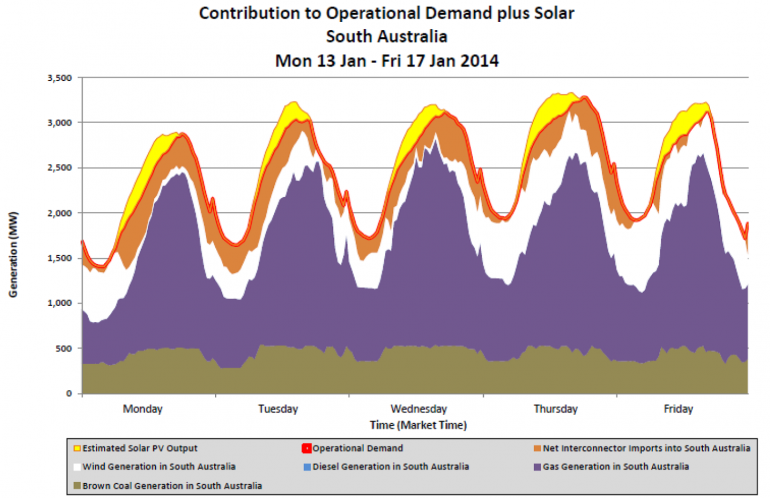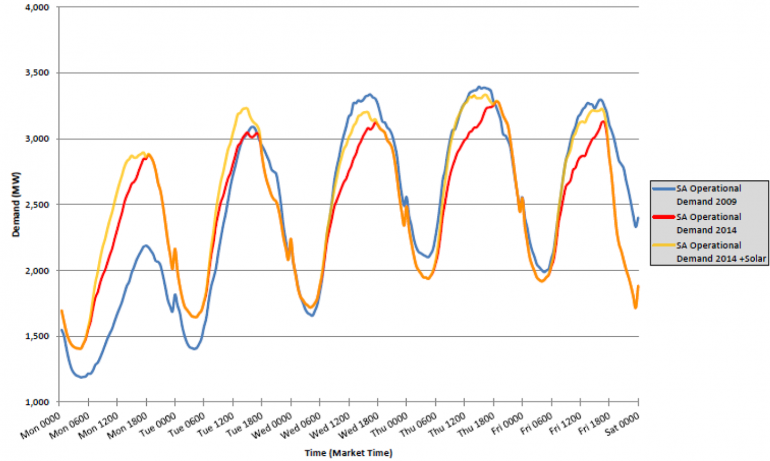AEMO's verdict on wind, solar and boiling hot weather
The Australian Energy Market Operator has released a report assessing how the electricity system stood up over the Victoria-South Australia heatwave of January 13 to 17. AEMO points out that the heatwave involved some extraordinary weather conditions which, perhaps, act as an exclamation point on the fact that demand still fell short of the 2009 record, in spite of notable economic and population growth since that time.
In terms of Adelaide weather, it was the first ever five-day period with a string of maximums above 42 degrees and the hottest maximum five-day average temperature; 43.6 degrees, which included the fourth hottest day on record (45.1 degrees).
For Melbourne, it experienced its first ever four-day period of maximum temperatures above 41 degrees (January 14 to 17) and the maximum temperature averaged over those four days was the hottest four-day stretch ever.
In spite of this extraordinary heat and the fact that some seem to think this event necessitates an urgent rethink of policy settings, particularly on renewable energy, AEMO noted:
The NEM power system proved capable during this high demand period, with demand able to be supplied at all times. While minimum reserve levels were at times low, AEMO did not require any load shedding.
Of course this is not to suggest it was all smooth sailing. AEMO also noted:
Low periods of reserve were at times a cause for concern, with generation assets at Loy Yang and Torrens Island being either out of service due to faults, or limited in their output as a consequence of the heat.
In the end the transmission line between Tasmania and Victoria, Basslink, proved vital in the face of problems with these conventional generators although it, too, experienced an outage. The table below summarises the major supply outages over the heatwave and their implications.
Figure 1: Major sources of supply outages during heatwave
AEMO has also made an effort to analyse the role of wind and solar over the period of the heatwave. The numbers aren’t all that different to what has already been covered in Climate Spectator here and here. Nonetheless, the operator has added an additional dimension by showing the contribution of all technologies to meeting demand.
As you’d expect, renewables weren’t a big player in Victoria which is hardly interesting given their small share of generating capacity in that state. However in South Australia renewables represent a sizeable proportion of electricity supply capacity, making it useful in trying to understand what we might need to prepare for in the future. The chart below details sources of power supply in South Australia over time during the week of the heatwave, according to AEMO.

Wind power’s contribution, illustrated in white, was very small on Monday and Wednesday’s peaks but represented a sizeable proportion of supply during peaks on the other three days. It obviously isn’t going to replace the need for capacity from controllable sources of power but ... branding it useless, as some seem keen to do, doesn’t mesh too well with the fact it did a pretty good job of displacing fossil fuels and injecting greater competition into the market on three of the five days.
Solar represents a much smaller amount of installed capacity than wind, but according to AEMO,
In another chart AEMO helps to better highlight how solar photovoltaic panels may be altering the time profile of demand levels for electricity from the wholesale market (large centralised generators) relative to the past. The chart shows demand across the 2009 heatwave period, in blue, when solar installed capacity was negligible and then the implied shape of demand over the 2013 heatwave with and without solar generation (solar output is not measured directly by AEMO but rather estimated from modelling).
Relative to 2009, peaks in demand for centralised generators (the red line) tend to be squashed downward and compressed into a shorter period later in the day. But once you take into account output from solar (yellow line) demand profiles look more similar to the shape in 2009.
Figure 3: South Australian electricity demand profile 2009 v 2013 with the influence of solar PV

This actually highlights quite an important potential trap in evaluating the extent to which solar may be moderating peak demand, and therefore the periods of very high wholesale prices. Solar is essentially invisible to most participants in the market and associated policy analysts because it doesn’t get measured in the market data AEMO collects and makes available every day. What they see is solely generation in the wholesale market.
If you were to solely look at this data you’d think demand was peaking quite late in the afternoon and at that time solar’s power output is dropping away. Yet that’s an incomplete picture and, in fact, demand for electricity is peaking a few hours earlier when solar’s output is considerably higher.
If you were to just judge solar on the time at which demand peaked on the wholesale market in South Australia, you’d think its contribution was negligible. For example, AEMO estimates over the week that it averaged only 2 per cent of supply at the time of wholesale market peak. This was precisely the mistake the Electricity Supply Association made in a press release on January 14 which fuelled a frenzy of criticism about renewable energy being useless.
















